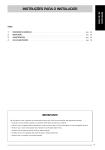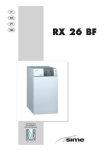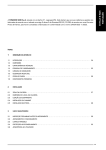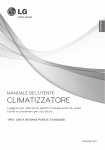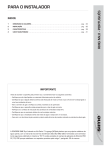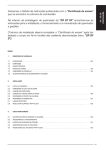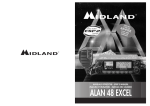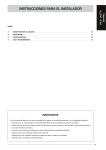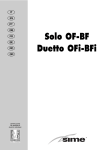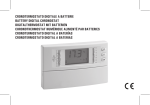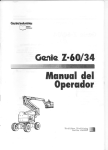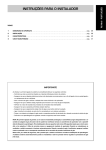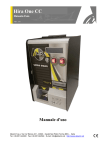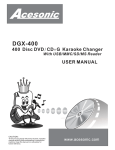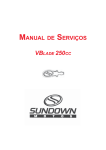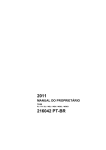Download 1 2 3 - Sime
Transcript
SOLO - DUETTO PORTUGUÊS INSTRUÇÕES PARA O INSTALADOR INDICE 1 DESCRIÇÃO DO APARELHO . . . . . . . . . . . . . . . . . . . . . . . . . . . . . . . . . . . . . . . . . . . . . . . . . . . . . . . . . . . . . . . . . . . . . . . . . . . pag. 46 2 INSTALAÇÃO . . . . . . . . . . . . . . . . . . . . . . . . . . . . . . . . . . . . . . . . . . . . . . . . . . . . . . . . . . . . . . . . . . . . . . . . . . . . . . . . . . . . . . . . . pag. 3 CARACTERISTICA . . . . . . . . . . . . . . . . . . . . . . . . . . . . . . . . . . . . . . . . . . . . . . . . . . . . . . . . . . . . . . . . . . . . . . . . . . . . . . . . . . . . pag. 59 4 USO E MANUTENÇÃO . . . . . . . . . . . . . . . . . . . . . . . . . . . . . . . . . . . . . . . . . . . . . . . . . . . . . . . . . . . . . . . . . . . . . . . . . . . . . . . . pag. 59 51 IMPORTANTE No momento em que o aparelho for aceso pela primeira vez, è boa norma proceder aos seguintes controles: – Controlar que não esistam liquidos ou materiais inflamáveis, prossimos a caldeira. – Acertar-se que a ligação elétrica seja feita in modo correto e que o fio terra seja ligado a uma boa ligação de terra. – Verificar que o tubo de evacuação dos produtos de combustão sejam livres. – Verificar que as eventuais portas de ferro sejam abertas. – Certificar-se que a instalaçào seja cheia de água e resulte esbaforida. – Verificar que o circulador não resulte blocado. 45 1 DESCRIÇÕES DO APARELHO 1.1 INTRODUÇÃO O grupo térmico construído em ferro fundido com queimador pressurizado integrado destaca-se pela sua qualidade, fiabilidade e baixo ruído, sendo projectado de acordo com a Directiva de Rendimento CEE 92/42. A combustão perfeitamente equilibrada e os elevados 1.2 rendimentos permitem obter grande economia na sua utilização. Neste manual encontram-se as instruções relativas aos seguintes modelos: – “SOLO 20-30-40 OF/30-40 BF” para Aquecimento Central. – “DUETTO 20-30-40 OFi/30-40 BFi” para Aquecimento Central e produção de água quente sanitária através de permutador instantâneo. As versões “BF-BFi” são caldeiras com queimador a combustão estanque. As instruções constantes neste manual, devem ser seguidas, para uma instalação correcta e um perfeito funcionamento do aparelho. DIMENÇÕES Modelo “SOLO 20-30-40 OF/DUETTO 20-30-40 OFi” Modelo “SOLO 30-40 BF/DUETTO 30-40 BFi” P M R C1 E U S Profondidade Passada ao circuito Retorno do circuito Carregamento da instalação Entrada dos sanitários Saida dos sanitários Escoamento da caldeira SOLO 20 OF 650 G 1” (UNI ISO 228/1) G 1” (UNI ISO 228/1) G 1/2” (UNI ISO 228/1) – – G 1/2” (UNI ISO 228/1) SOLO 30-40 OF/BF 750 (30 OF/BF) - 850 (40 OF/BF) G 1” (UNI ISO 228/1) G 1” (UNI ISO 228/1) G 1/2” (UNI ISO 228/1) – – G 1/2” (UNI ISO 228/1) DUETTO 20-30-40 OFi/30-40 BFi 650 (20 OFi) - 750 (30 OFi/BFi) - 850 (40 OFi/BFi) G 1” (UNI ISO 228/1) G 1” (UNI ISO 228/1) – G 1/2” (UNI ISO 228/1) G 1/2” (UNI ISO 228/1) G 1/2” (UNI ISO 228/1) Fig. 1 46 1.3 DADOS TECNICOS SOLO 20 OF SOLO 30 OF/BF SOLO 40 OF/BF kW 18,9-23,5 (20,7) 24,5-31,3 (27,5) 32,5-40,0 (35,2) kcal/h 16.300-20.200 21.100-26.900 28.000-34.400 kcal/h (17.800) (23.700) (30.300) kW 21,1-26,2 (23,0) 27,2-34,8 (30,6) 36,0-44,3 (39,0) kcal/h 18.100-22.500 23.400-29.900 31.000-38.100 kcal/h (19.800) (26.300) (33.500) B23 B23 B23 n° 3 4 5 bar 4 4 4 l 18 22 26 l/bar 10/1 10/1 10/1 Min. - Max. mbar 0,05-0,11 0,12-0,16 0,15-0,21 Pressão câmera combustão ** mbar – 0,02 – 0,02 – 0,05 mbar 0,07-0,13 0,14-0,18 0,17-0,23 °C 160-185 160-185 160-185 24,0-31,6 (26,4) 32,4-41,4 (35,9) 42,9-52,8 (46,3) Potência termica min.-max.* Caudal termico min.-max.* Tipo Elementos Pressão max. de exercicio Capacidade de água Vaso de espansão Capacidade/Pressão pre-carga Perdas de cargo lado do fumo Depressão aconselhada da chaminé ** Min. - Max. Temperatura do fumo min.-max. Carga de fumo min.-max.* m3n/h CO2 % 12,5 12,5 12,5 Temperatura max. funcionamento °C 95 95 95 Potência elétrica assorbida “OF/BF” W 220 200/230 180/210 Campo de regolazione aquecimento °C 45÷85 45÷85 45÷85 l/min – – – l/h – – – l/min – – – Pressão max. de exercicio dos fervidores bar – – – 0,50-0,60 60°W 0,60-0,75 60°W 0,75-0,85 60°W (0,50 60°W) (0,65 60°W) (0,85 60°W) 12-12 (14) 14-14 (14) 14-14 (12) 3,2-3,7 (3,4) 3,0-5,2 (4,1) 5,0-6,2 (5,3) descarga coaxial ø 80/125 – 1,7-4,1 (4,0) 1,8-3,6 (2,4) condutas separadas ø 80 – 1,0-2,0 descarga coaxial ø 80/125 – D-G (D) condutas separadas ø 80 – M 112 137 Produção de água sanitaria Carga sanitario especifico EN 625 Carga sanitario continuo ∆t 30°C * Carga sanitario minimo Queimadores de combustivel *** Injetor dos queimadores* Pressão bomba min.-max.* bar Posiçào fechamento min.-max. para “OF” * Posiçào fechamento min.-max. para “BF” *: – Posição do diafragma para “BF” *: Peso kg – 162 * Os dados indicados entre parêntises referemse à regulação de fábrica ** Somente para versión “OF” *** Quando se modificam as condições de calibragem do queimador verificar sempre os valores de CO2. 47 DUETTO 20 OFi DUETTO 30 OFi/BFi DUETTO 40 OFi/BFi 23,5 (20,7) 31,3 (27,5) 40,0 (35,2) kcal/h 20.200 26.900 34.400 kcal/h (17.800) (23.700) (30.300) 26,2 (23,0) 34,8 (30,6) 44,3 (39,0) kcal/h 22.500 29.900 38.100 kcal/h (19.800) (26.300) (33.500) B23 B23 B23 n° 3 4 5 bar 4 4 4 l 18 22 26 l/bar 10/1 10/1 10/1 Min. - Max. mbar 0,11 0,16 0,21 Pressão câmera combustão ** mbar – 0,02 – 0,02 – 0,05 mbar 0,13 0,18 0,23 °C 185 185 185 31,6 (26,4) 41,4 (35,9) 52,8 (46,3) Potência termica min.-max.* Caudal termico min.-max.* kW kW Tipo Elementos Pressão max. de exercicio Capacidade de água Vaso de espansão Capacidade/Pressão pre-carga Perdas de cargo lado do fumo Depressão aconselhada da chaminé ** Min. - Max. Temperatura do fumo min.-max. Carga de fumo min.-max.* m3n/h CO2 % 12,5 12,5 12,5 Temperatura max. funcionamento °C 95 95 95 Potência elétrica assorbida “OFi/BFi” W 215 200/230 180/210 Campo de regolazione aquecimento °C 45÷85 45÷85 45÷85 l/min 9,7 (8,7) 12,5 (11,0) 16,0 (14,2) 670 (590) 890 (780) 1.140 (1.000) 2,5 2,5 2,5 6 6 6 0,60 60°W 0,75 60°W 0,85 60°W (0,50 60°W) (0,65 60°W) (0,85 60°W) 12 (14) 14 (14) 14 (12) 3,7 (3,4) 5,2 (4,1) 6,2 (5,3) descarga coaxial ø 80/125 – 4,1 (4,0) 3,6 (2,4) condutas separadas ø 80 – 1,0-2,0 – descarga coaxial ø 80/125 – G (D) – condutas separadas ø 80 – M – 151 176 201 Produção de água sanitaria Carga sanitario especifico EN 625 Carga sanitario continuo ∆t 30°C * Carga sanitario minimo Pressão max. de exercicio dos fervidores l/h l/min bar Queimadores de combustivel *** Injetor dos queimadores* Pressão bomba min.-max.* bar Posiçào fechamento min.-max. para “OFi” * Posiçào fechamento min.-max. para “BFi” *: Posição do diafragma para “BFi” *: Peso * ** *** 48 kg Os dados indicados entre parêntises referemse à regulação de fábrica Somente para versión “OFi” Quando se modificam as condições de calibragem do queimador verificar sempre os valores de CO2. 1.4 COMPONENTES PRINCIPAIS 1.4.1 Modelo “SOLO 20-30-40 OF/30-40 BF” 3 4 5 LEGENDA 1 Queimador de combustivel 2 Bainha de alojamento dos sensores 3 Painel de controle 4 Enchimento 5 Pressostato água 6 Hidrometro 7 Circolador do implanto 8 Aspiração do ar do queimador estanque (versão “BF”) 2 8 6 7 1 Fig. 2 1.4.2 Modelo “DUETTO 20-30-40 OFi/30-40 BFi” 3 4 5 8 2 7 10 6 11 12 9 LEGENDA 1 Queimador de combustivel 2 Bainha de alojamento dos sensores 3 Painel de controle 4 Fervidor instantâneo 5 Enchimento 6 Circolador do fervidor 7 Pressostato água 8 Hidrometro 9 Circolador do implanto 10 Aspiração do ar do queimador estanque (versão “BFi”) 11 Valvula de retenção 12 Valvula de esfogo 1 11 Fig. 2/a 49 1.5 ESQUEMA FUNCIONAL 1.5.1 Modelo “SOLO 20-30-40 OF/30-40 BF” LEGENDA 1 Corpo da caldeira 2 Enchimento 3 Valvula de segurança da caldeira 4 Valvula de esfogo automatico 5 Vaso espansão 6 Queimador de combustivel 7 Circulador do implanto 8 Hidrometro 9 Torneira de descarga da caldeira 10 Pressòstato água Fig. 3 1.5.2 Modelo “DUETTO 20-30-40 OFi/30-40 BFi” LEGENDA 1 Corpo da caldeira 2 Enchimento 3 Valvula de segurança da caldeira 4 Valvula de esfogo automatica 5 Vaso espansão 6 Queimador de combustivel 7 Circulador do implanto 8 Hidrometro 9 Torneira de descarga da caldeira 10 Pressòstato água do implanto 11 Pressòstato água sanitaria 12 Acumulador instantaneo 13 Valvula de retençáo 14 Valvula de esfogo 15 Circulador de fervidor Fig. 3/a 50 2 INSTALAÇÀO 2.1 LOCALIZAÇÃO DA CALDEIRA As caldeiras com potências superiores a 35 kW, devem dispor de uma zona técnica com características e requisitos em conformidade com normas e regulamentos actualmente em vigor. Entre as paredes internas do local e a caldeira, deve ser deixado um espaço de, pelo menos, 0,60 m, enquanto que entre a parte superior da caldeira e o tecto deve existir uma distância de, pelo menos, 1,0 m, que pode ser diminuída a 0,50 m para as caldeiras com acumuladores integrados (todavia a altura min. do compartimento caldeira não pode ser inferior a 2,5 m). As caldeiras com potências inferiores a 35 kW, devem ser instaladas e funcionar somente em lugares constantemente ventilados. É, então necessário, para a circulação de ar no local, prever nas paredes externas, aberturas que correspondam aos seguintes requisitos: – Devem ter uma secção livre total de pelo menos 6 cm2, por cada kW de capacidade térmica, com um mínimo de 100 cm2. – Estar situadas o mais perto possível do pavimento, não obstruídas e protegidas com uma grelha que não diminua a secção útil de passagem do ar. 2.2 INSTALAÇÃO E ARRANQUE DA CALDEIRA Antes de proceder ao acendimento da caldeira é bom deixar circular água nos tubos para eliminar os eventuais corpos estranhos que poderiam comprometer o bom funcionamento do aparelho. Ao efectuar a ligação hidráulica certifique-se que as dimensões da figura 1 são respeitadas. É aconselhável que esta ligação seja facilmente desmontável. O tubo de descarga da válvula de segurança deve ser ligado a um sistema adequado de drenagem. que bolhas de ar possam sair através dos purgadores de ar. Para facilitar esta operação, posicionar horizontalmente o entalhe do parafuso de desbloqueio das válvulas de retenção. Terminada a fase de enchimento recolocar o parafuso na posição inicial. No fim da operação controlar que a torneira seja fechada (figura 4). ABRE Fig. 4 Para evitar a formação de incrustações de calcário e de danos no permutador de água quente, a água de alimentação não deve ter uma dureza superior aos 20°F. De qualquer modo é necessário verificar as características da água utilizada e instalar dispositivos adequados para o tratamento. Para evitar incrustações ou depósitos no permutador primário, também a água de alimentação do circuito de aquecimento deve ser tratada em conformidade com a norma UNI-CTI 8065. É absolutamente indispensável tratar a água nos seguintes casos: – Instalação muito extensa (com elevado conteúdo de água ). – Frequente adição de água à instalação. – No caso em que seja necessário o esvaziamento parcial ou total da instalação. 2.3 2.2.2 Produção de água sanitária “DUETTO OFi/BFi” Para regular o caudal de água sanitária actuar no regulador de caudal do pressóstato da água (fig. 5): - Girando no sentido dos ponteiros do relógio o regulador reduz o caudal de admissão de água sanitária aumentando consequentemente a sua temperatura. - Girando no sentido inverso o regulador aumenta o caudal de admissão de água sanitária diminuindo consequentemente a sua temperatura. REGULADOR REGOLATORE DEPORTATA CAUDAL DI 2.2.1 Enchimento da instalação O enchimento da caldeira e da respectiva instalação efectua-se através de válvulas de enchimento torneiras, devendo a pressão de carga, com o equipamento frio, estar compreendida entre 1 e 1,2 bar. Durante a fase de enchimento da instalação é aconselhável manter o interruptor geral desligado. O enchimento deve ser feito lentamente para 2.2.3 Características da água de alimentação Fig. 5 EVACUAÇÃO DOS FUMOS 2.3.1 Ligação da chaminé A chaminé tem uma importância fundamental para o funcionamento do equipamento. Tanto é que se não for correctamente dimensionada podem suceder disfunções no queimador, ampliação dos ruídos, formação de fuligem, condensação e encrostação. Uma chaminé deve, então responder aos seguintes requisitos: – Deve ser de material impermeável e resistente à temperatura do fumo e relativas condensações; – Deve ser de suficiente resistência mecânica e de pouca conductividade térmica; – Deve ser perfeitamente isolada, para evitar o seu arrefecimento; – Deve ter um desenvolvimento o mais vertical possível e na parte final deve haver um terminal que assegure uma eficiente e constante evacuação dos produtos da combustão. – Com intenção de evitar que o vento possa criar retorno à chaminé e zonas de pressão, tais que impeçam a exaustão dos gases de combustão, é necessário que a descarga da chaminé esteja, pelo menos, 0,4 m acima qualquer estrutura adjacente a própria chaminé (incluindo o ponto mais alto do telhado ) distantes menos de 8 m; – A chaminé deve ter um diâmetro não inferior ao de união da caldeira com a chaminé: para chaminés com 51 secção quadrada ou rectangular , a secção interna deve ser aumentada 10% relativamente à secção da união da caldeira com a chaminé; – A secção útil da chaminé pode ser calculada do seguinte modo: P S = K S K P H Secção resultante em cm2 Coeficiente em redução: 0,024 Potência da caldeira em kcal/h Altura da chaminé, em m, medida do eixo da chama à descarga da chaminé na atmosfera. No dimensionamento da chaminé deve-se ter em atenção a altura efectiva da chaminé em m, medida do eixo da chama ao ponto mais alto em cima, diminuída de: √H – 0,50 m por cada mudança de direcção do tubo de chaminé; – 1,00 m por cada m percorrido horizontalmente. As nossas caldeiras são de tipo B23 e não precisam de particulares ligações, senão a ligação à chaminé como é especificado em cima. 2.3.2 O comprimento máximo da conduta não dever á ser super ior a 7,0 metros equivalentes. As perdas de carga em metros por cada acessório a utilizar na configuração de evacuação estão indicadas na Tabela A. Utilizar exclusivamente acessórios de origem SIME e cer tificar-se que a ligação seja efectuada correctamente, como indicado nas instruções fornecidas com os acessórios. Evacuação dos fumos com conduta coaxial ø 80/125 2.3.3 As caldeiras da versão “BF - BFi” estão preparadas para a ligação a condutas coaxiais de evacuação em aço inox ø80/125 que se podem orientar na direcção mais adequada às exigências do local (fig. 6). Saída de fumos com condutas separadas ø 80 As caldeiras versão “SOLO 30 BF DUETTO 30 BFi” estão predispostas para a ligação a condutas separadas em aço inox ø 80 que se podem min. 715 LEGENDA 1 Tubo coaxial em aço inox L. 886 cód. 8096220 2 a Extensão em aço inox L. 1000 cód. 8096121 2 b Extensão em aço inox L. 500 cód. 8096120 3 a Curva a 90° em aço inox cód. 8095820 3 b Curva a 45° em aço inox cód. 8095920 4 Recuperação da condensação vertical em aço inox L. 135 cód. 8092820 5 Telha com articulação cód. 8091300 6 Terminal de saida telhado L. 1063 cód. 8091203 7 Kit cód. 8098810 6 TABELA A Perda de carga (m) Curva em aço inox a 90° MF 1,80 Curva em aço inox a 45° MF 0,90 Extensão em aço inox L. 1000 1,00 Extensão em aço inox L. 500 0,50 Terminal de saida telhado L. 1063 1,00 Tubo coaxial em aço inox L. 886 0,70 Recuperação da condensação vertical em aço inox L. 135 0,70 1 5 3 2 2 4 7 3 3 7 ø 80/125 ATENÇÃO: O comprimento máximo da conduta não deverá ser superior a 7,0 metros equivalentes. Nas saídas com evacuação vertical, utilizar sempre a recuperação da condensação (4). Fig. 6 52 orientar na direcção mais adequada às exigências do local (fig. 6/a): - Conduta aspiração: o comprimento máximo permitido da conduta não deverá ser superior a 16 metros equivalentes. - Conduta de descarga: o comprimento máximo permitido da conduta não deverá ser superior a 6 metros equivalentes. Nas saídas pelo tecto utilizar sem- pre a recuperação da condensação e o comprimento máximo ver tical, sem mudanças de direcção, não deverá ser superior a 7,6 metros. As fugas de carga em metros para cada acessório a utilizar nas configurações de aspiração e de descarga está indicada na Tabela B. Utilizar exclusivamente acessórios ori- ginais SIME e verificar se a ligação é feita de modo correcto, assim como indicado pelas instruções fornecidas com os acessórios. 2.4 ALIMENTAÇÃO DE COMBUSTÍVEL O grupo térmico está preparado para receber a alimentação do combustível min. 700 LEGENDA 1 Terminal de descarga cód. 8089501 2 a Extensão em aço inox L. 1000 2 b Extensão em aço inox L. 500 3 a Curva a 90° em aço inox 3 b Curva a 45° em aço inox 4 Recuperação da condensação vertical em aço inox L. 148 5 Telha com articulação cód. 8091300 6 Terminal de saida telhado L. 1063 7 Kit de descarga L. 224 cód. 8098811 8 Terminal de aspiração cód. 8089500 9 Kit braçadeiras interior-exterior cód. 8091500 TABELA B 1 Perda de carga (m) 1,00 0,60 1,00 0,50 1,00 0,40 0,10 1,50 2 2 5 2 2 4 7 3 9 2 8 2 max max16 16mmequivalentes equivalenti ATENÇÃO:: 3/10 3 9 8 2 6 max 7,67,6 mm verticais max verticali Curva em aço inox a 90° MF Curva em aço inox a 45° MF Extensão em aço inox L. 1000 Extensão em aço inox L. 500 Terminal de saida telhado L. 1063 Terminal de descarga Terminal de aspiração Recuperação da condensação vertical em aço inox L. 148 3 9 2 7 2 max 1616mmequivalentes max equivalenti O comprimento máximo da conduta de aspiração não deverá ser superior a 16 metros equivalentes. O comprimento máximo da conduta de descarga não deverá ser superior a 6 metros equivalentes. Nas saídas pelo tecto utilizar sempre a recuperação da condensação (4) e o comprimento máximo vertical da conduta, sem mudanças de direcção, não deverá ser superior a 7,6 metros. Fig. 6/a 53 TABELA 1 H metri H max 4 m H lateralmente, os tubos devem passar através de aberturas predispostas nos lados direito e esquerdo da envolvente para poderem ser ligados à bomba (fig. 7 - 7/a). 0 0,5 1 1,5 2 3 3,5 Advertência importante H – Certifique-se, antes de acender o queimador, que o tubo de retorno não esteja obstruído. Uma excessiva contra pressão pode provocar a deterioração de componentes da bomba. L (metri) øi tubo øi tubo 8 mm 10 mm 35 100 30 100 25 100 20 90 15 70 8 30 6 20 H = Desnivel L = Maxima comprimento do tubo de aspiração – Certifique-se que os tubos são resistentes. – Não se deve superar a depressão máxima de 0,4 bar (300 mmHg) (Tabela 1). Acima de tal valor dá-se a cavitação que pode gerar deterioração da bomba. – Nas ligações em depressão é aconselhável fazer chegar o tubo de retorno à mesma altura do tubo de aspiração. Neste caso não é necessária a válvula de fundo. Se o tubo de retorno chega depois do nível de combustível a válvula de fundo é indispensável. Fig. 7 LIGAÇÕES 1 Ligação vacuometro 2 Regularizador de pressão 3 Tomada manômetro 4 Parafusos de bay-pass 5 Retorno flexivel (fornido) 6 Aspiração flexivel (fornido) 7 Tomada de pressão auxiliar 8 Valvula 9 Ligação 3/8" (fornido) 10 Filtro da linha de alimentação combustivel (fornido) 8 1 2 3 7 Funcionamento bomba 9 Para ligar a bomba, basta acender o queimador e verificar o acendimento da chama. Se o queimador entra em bloqueio, antes de chegar o combustível, esperar no min. 20 segundos, e depois apertar o botão de desbloqueio do queimador - RESET e esperar que seja feito de novo toda a fase de acendimento até o acendimento da chama. 2.5 REGULAÇÃO DO QUEIMADOR Cada aparelho é fornecido com uma unidade de combustão completa préafinada em fabrica; todavia é melhor verificar os parâmetros reportados ao ponto 1.3, que são referidos à pressão atmosférica ao nível do mar. No caso que o equipamento necessite de regulação diferente daquela de fabrica, estas podem ser feitas somente pelo pessoal autorizado, seguindo as instruções acima dispostas: para chegar aos órgãos de regulação da unidade de combustível, remover a porta da caldeira. 54 10 9 4 6 5 ATENÇÃO: - Afroxar as junta ligadas a bomba (5-6) antes de orientar os flexiveis para tirar-los fora da abertura pre-disposta nos lados dir/esq da capa. Uma volta efetuada a operação fechar a junta da bomba. - A bomba è pre-disposta para o funcionamento bi-cano, para o funcionamento monocano, é necessário tirar o parafuso de bay-pass (4). Fig. 7/a 2.5.1 Regulação de ar do queimador 2.5.2 Regulação da pressão da bomba Para efectuar a regulação de ar do queimador, actuar nos parafusos (1 fig. 8) e ter em atenção a escala graduada (2 fig. 8) que indica a posição da porta. Os valores de regulação para cada equipamento estão indicados no ponto 1.3. Para efectuar a regulação da pressão do combustível actuar nos parafusos (3 fig. 8/a) e verificar através de um manómetro ligado à tomada, (2 fig. 8/a) que a pressão esteja conforme os valores indicados no ponto 1.3. RESET TWICE ONLY 5 6 2 7 1 Fig. 8 12 bar 3 2 LEGENDA 1 Bomba de combustivel 2 Tomada do manômetro 3 Parafuso de regulação da pressão 1 Fig. 8/a 2.6 PRÉ-AQUECIMENTO Nas versões “SOLO 20-30 OF/BF” o pré-aquecimento entra em funcionamento sempre que é necessário o funcionamento do queimador, retardando o seu arranque por um tempo máximo de 90 seg. necessários a elevar a temperatura do combustível, a 65ºC, na zona do injector .Uma vez atingida a temperatura o termostato colocado sobre o pré-aquecedor dá ordem para o acendimento do queimador (1 fig. 15/b). O pré-aquecimento continua em funcionamento durante todo o período de funcionamento do queimador, desactivando-se quando o mesmo se desliga. A versão “DUETTO 20-30 OFi/30 BFi” dispõe de um pré-aquecedor de potência mais baixa, que no período de inverno, está sempre activo, desde o momento em que se acende o interruptor geral do quadro de comando. Aquando do primeiro arranque no período de Inverno, pode suceder que o queimador tenha dificuldade para acender-se, existindo a possibilidade de bloqueio, porque o ciclo de acendimento se inicia antes que o combustível chegue a temperatura correcta. Na altura em que o queimador arranca de novo, terá passado tempo suficiente ( 2 ou 3 min.), para que o combustível atinja a temperatura correcta para o acendimento do queimador. O pré-aquecimento não é montado nas versões “SOLO 40 OF/BF - DUETTO 40 OFi/BFi” porque não é necessário. mentação eléctrica e deverá ser alimentada, com tensão monofásica 230V/50Hz, através de um interruptor geral, protegido por fusível. O cabo do termostato ambiente, cuja instalação é aconselhável para obter um melhor controle da temperatura ambiente, deverá ser ligado como mostra a figura 9 - 9/a. 2.7 Antes de efectuar qualquer operação no quadro eléctrico, desligue a alimentação eléctrica. LIGAÇÕES ELÉCTRICAS A caldeira é fornecida com cabo de ali- NOTA: O aparelho deve ser conectado a uma eficaz ligação à terra. A SIME não se responsabiliza por danos causados a pessoas derivados da falta da ligação à terra. 55 56 NOTAS: Ligando o termóstato de ambiente (TA) retirar a ponte entre os bornes 4-5. Ligando a central RVA 43.222 retirar as pontes 4-5 e 4-6. Ligando o relógio programador (OP) retirar a ponte entre os bornes 5-8. LEGENDA IG Interruptor geral TS Termostato de segurança TC Termostato da caldeira SPA Luz de intervenção do pressóstato da água SA Luz de presença de corrente eléctrica SB Botão de bloco do queimador PA Pressostato água P Bomba instalação B Queimador TA Crono-termostato C Conectores da central RVA 43.222 (opcional) SS Sonda de imersão no fervedor QAZ21 (opcional) SC Sonda de imersão na caldeira QAZ21 (opcional) SE Sonda da temperatura externa QAC31 (opcional) UA Unidade ambiente QAA70 (opcional) PB Bomba do fervedor OP Relógio programador 2.7.1 Esquema elètrico “SOLO 20-30-40 OF/30-40 BF” Fig. 7 ROSSO - RED MARRONE - BROWN NERO - BLACK NOTAS: Ligando o termóstato ambiente (TA) retirar a ponte entre os bornes 17-18. Ligando a central RVA 43.222 retirar as pontes 13-14 e 17-18. Ligando o relógio programador (OP) retirar a ponte entre os bornes 15-16. LEGENDA IG Interruptore geral R Relé TM Termostato de minima TL Termostato limite VP Válvula pressóstato TS Termostato de segurança E/I Interruptor verão/inverno TC Termostato caldeira SPA Luz de intervenção do pressóstato da água SA Luz de presença de corrente eléctrica SB Tomada de bloco do queimador PA Pressostato água PI Bomba de instalação PB Bomba de acumulador B Queimador TA Crono-termostato C Conectores da central RVA 43.222 (opcional) SS Sonda de imersão no fervedor QAZ21 (opcional) SC Sonda de imersão na caldeira QAZ21 (opcional) SE Sonda da temperatura externa QAC31 (opcional) UA Unidade ambiente QAA70 (opcional) OP Relógio programador 2.7.2 Esquema elétrico “DUETTO 20-30-40 OFi/30-40 BFi” Fig. 7/a 57 2.7.3 Diagrama de funcionamento “SOLO 20-30 OF/BF - DUETTO 20-30 OFi/30 BFi” Normal Bloco por não ascenção Consentimento de ascenção Termostato do aquecedor Aquecedor Motor Transformador de ascenção Valvula de combustivel Chama Lampada de blocagem 0÷150 s ~ 12 s 0÷150 s ~ 12 s ~5 s NOTA: Na versão DUETTO 30 OFi/BFi sem o termostato, o aquecedor de Inverno e sempre ativo. 2.7.4 Diagrama de Funcionamento “SOLO 40 OF/BF - DUETTO 40 OFi/BFi” Normal Bloco por não ascenção Consentimento de ascenção Motor Transformador de ascenção Valvula de combustivel Chama Lampada de blocagem ~ 12 s 58 ~ 12 s ~5 s 3 CARACTERISTICAS 3.1 DIMENSÃO DA CÂMARA DE COMBUSTÃO 3.2 PREVALÊNCIA DISPONÍVEL AO APARELHO A prevalência resídua para o equipamento de aquecimento, é representada, em função do caudal, pelo gráfico da fig. 11. L 270 Fig. 10 500 SOLO - DUETTO OF/BF Volume dm3 17,5 24,0 30,5 17,5 24,0 30,5 PREVALÊNCIA RESIDUA RESÍDUA (mbar) PREVALENZA SOLO 20 OF SOLO 30 OF/BF SOLO 40 OF/BF DUETTO 20 OFi DUETTO 30 OFi/BFi DUETTO 40 OFi/BFi L mm 305 405 505 305 405 505 280 A câmara de combustão é do tipo passagem directa, e é conforme a norma EN 303-3 anexo E. As dimensões são indicadas na figura 10. Um painel especifico de protecção é aplicado na parede interna do cabeçote posterior de todos os modelos. 400 300 200 100 0 200 400 600 800 1000 1200 1400 1600 1800 2000 CAUDAL (l/h) (l/h) PORTATA SOLO OF/BF DUETTO OF/BF - OFi/BFi Fig. 11 4 USO E MANUTENÇÃO 4.1 CENTRAL RVA 43.222 (opcional) O painel de controle permite a utilização de uma central RVA 43.222 (cód. 8096303) fornecido sob encomenda, junto com um manual de instruções para a montagem (figura 12). Efectuar a ligação eléctrica como é indicado no parágrafo 2.7. 4.4 DESMONTAGEM DA ENVOLVENTE Para uma fácil manutenção da caldeira, é possível desmontar completamente a envolvente, seguindo a ordem da figura 14. 4.5 DESMONTAGEM DO VASO DE EXPANSÃO Para a desmontagem do vaso de expansão de aquecimento proceder no TIRAR Fig. 12 59 seguinte modo: – Certifique-se que a caldeira tenha sido esvaziada de água. – Desparafusar a ligação que une o vaso de expansão. – Retirar o vaso expansão. Antes de proceder ao enchimento do equipamento certifique-se, que o vaso de expansão esteja com uma précarga de 0,8÷1 bar. 2 6 4.6 MANUTENÇÃO DO QUEIMADOR 3 1 Para desmontar o queimador do corpo da caldeira tirar a porca (fig. 15). – Para chegar a zona interna do queimador retire o sistema de regulação do ar, fixo através de dois parafusos laterais e remova a tampa direita, fixa com quatro parafusos, tendo em atenção para não danificar as juntas de vedação OR. – Para desmontar o porta-injector e o grupo de pré-aquecimento agir no seguinte modo: – Abrir a tampa do aparelho, fixa com um parafuso, desligue os cabos do pré-aquecimento (1 figura 15/a) protegidos por uma bainha termoresistente que devem passar através do buraco, depois de ter tirado o respectivo passacabos. – Retirar os dois cabos dos eléctrodos de ignição fixos com faston. – Afrouxar a ligação (2 figura 15/a) e tirar os quatro parafusos que fixam a coleira (3 figura 15/a) ao queimador. – Para a desmontagem do pré-aquecedor ou do termostato ver figura 15/b. 4.7 4 5 Fig. 14 LIMPEZA E MANUTENÇÃO DA CALDEIRA Fig. 15 A manutenção preventiva, de controle 1 2 3 LEGENDA 1 Cabos dos aparelhos 2 Ligação 3 Coleira Fig. 15/a 60 1 LEGENDA 1 Termostato do aquecedor 2 Tampa 3 Aquecedor 2 3 Fig. 15/b de funcionamento dos aparelhos e do sistema de segurança, deverá ser feito no final de cada estação, exclusivamente do pessoal técnico e autorizado. 4.7.1 Limpeza da zona de passagem dos fumos RONDO' 3/4 OF ESTELLE 3/4 OF Para limpar a zona de passagem dos fumos, no corpo caldeira, utilizar um escovilhão especifico. Uma vez terminada a manutenção, posicionar os turbuladores na posição inicial (figura 16). RONDO' 5/6 OF ESTELLE 5/6 OF 4.7.2 Limpeza da cabeça de combustão Fig. 16 A 4 ± 0,3 mm Para efectuar a limpeza da cabeça de combustão proceder como se indica na figura 17: – Desligar os cabos de alta tensão dos eléctrodos. – Desparafusar o suporte do distribuidor e removê-lo. – Limpar delicadamente o distribuidor (disco de turbulência). – Limpar com cuidado os eléctrodos de ignição. – Limpar com cuidado a fotocélula de eventuais depósitos de sujidade que podem depositar-se na sua superfície. – Limpar os restantes componentes da cabeça de combustão com eventuais depósitos de sujidade. – Uma vez terminada a limpeza, remontar tudo, com o procedimento inverso daquele descrito anteriormente, tendo cuidado para manter as medidas indicadas. 2 - 2,5 mm 4.7.3 Substituição Injector Fig. 17 É aconselhável a substituição do injec61 tor no inicio de cada estação de aquecimento para garantir o correcto caudal de combustível e uma pulverização eficiente. Para substituir injector proceder no seguinte modo: – Desligar os cabos de alta tensão dos eléctrodos – Afrouxar o parafuso de fixação (a figura 15) do suporte eléctrodo e remove-lo. – Fixar o porta injector utilizando uma chave n°19 e desaparafusar o injector com uma chave n°16 (fig. 18). Uma anomalia no funcionamento, na maior parte dos casos, causa o acendimento do sinal de bloqueio no painel de controlo. Quando se acende este sinal, o queimador poderá funcionar de novo somente depois de ter pressionado o botão de desbloqueio; Uma vez realizada esta operação e a ignição ocorrer normalmente, a anomalia pode ser considerada transitória e não perigosa. Se, pelo contrário, o bloqueio continua , a causa da anomalia e a sua solução devem ser procurados na lista seguinte: O queimador não se acende – Verificar as ligações eléctricas. – Verificar o regular fluxo do combustível, a limpeza dos filtros, limpeza do injector e a eliminação de ar dos tubos. – Verificar o regular funcionamento do arco eléctrico de ignição e o funcionamento correcto do queimador. Fig. 18 4.8 ANOMALIAS DE FUNCIONAMENTO São indicadas algumas causas e os possíveis soluções de algumas anomalias que poderão acontecer e levar ao não funcionamento do aparelho. 62 Queimador faz a ignição correctamente, mas se desliga-se subitamente. – Verificar a fotocélula de detecção de chama, a regulação do ar e o funcionamento do aparelho. Dificuldade de regulação do queimador e/ou falta de rendimento – Verificar: o regular fluxo de combustível, a limpeza da caldeira, a não obstrução da conduta de descarga dos fumos, a real potência fornecida pelo queimador e a sua limpeza (poeira). A caldeira suja-se facilmente – Verificar a regulação do queimador (análise dos gases de combustão), a qualidade do combustível, a não obstrução da chaminé e a limpeza da admissão do ar do queimador (poeira). A caldeira não chega a temperatura – Verificar a limpeza do corpo da caldeira, a combinação, a regulação, as prestações do queimador, a temperatura pré-regulada, o funcionamento correcto e posicionamento do termostato de regulação. – Assegurar-se que a caldeira tem potência suficiente para a aplicação. Cheiro a combustível ,não queimado – Verificar a limpeza do corpo da caldeira e da descarga dos fumos, a estanquidade da caldeira, dos tubos de descarga (Porta da câmara de combustão, câmara de combustão, zonas de passagem de fumos, chaminé, juntas.) – Controlar a qualidade da combustão. Intervenção frequente da válvula de segurança da caldeira – Controlar a presença de ar na instalação, e o funcionamento dos circuladores. – Verificar a pressão de carga da instalação, a eficiência do vaso de expansão e a taragem da própria válvula. INSTRUÕES PARA O UTENTE ADVERTÊNCIAS – Em caso de defeito e/ou malfuncionamento do aparelho desactivar-lo, sem fazer nenhum tentativo de riconcertar-lo. Se, se averte odore de combustivel ou de combustão arear o lugar e fechar o dispositvo de intercetação do combustivel. Rivolger-se rapidamente ao pessoal autorizado. – A instalação da caldeira e qualquer outra intervenção de assistência e manutenção devem ser efetuadas por pessoal tecnico autorizado. – É severamente proibido obstruir ou reduzir a abertura de ariação do lugar aonde é instalado o aparelho. As aberturas de ariação são indispensáveis para uma justa combustão. ASCENÇÃO E FUNCIONAMENTO ASCENÇÃO CALDEIRA Para efetuar uma ascenção apertar o botão do interruptore geral. O acendimento do led verde permite verificar a presença de corrente eléctrica no aparelho (fig. 19). Nas versões “DUETTO 20-30-40 OFi/30-40 BFi” escolher a posição no desviador Staet Verão/Inverno (fig. 20): – Com o desviador em posição Led verde aceso Fig. 19 Fig. 20 ( STATE) a caldeira funciona como sanitàrio. – Com o desviador em posição (INVERNO) a caldeira funciona sia como sanitàrio que como aquecedor de ambiente. Será o regulador climatico a parar em tempo o funcionamento da caldeira. REGULAÇÃO TEMPERATURA A regulação da temperatura aquecedor se obtem agindo na manivela do termostato com campo de regulação da 45° a 85°C. O valor da temperatura escolhida se controla no termômetro. Para garantir um rendimento opti- mal do gerador se aconselha de não descer de uma temperatura minima de funcionamento de 60°C (fig. 21). TERMOSTATO DE SEGURANÇA O termostato de segurança em modalidade manual, intervem provocando o instantâneo desligamento do queimador quando a temperatura supera os 120°. Para reacender o aparelho desenrroscar a tampa de proteção e apertar o botão em baixo (fig. 22). Se a anomalia se verifica frequentemente pedir a intervençào do serviso tecnico autorizado, para um controle. 60°C Fig. 21 63 DESBLOCAGEM DO QUEIMADOR No caso em que se verificasse anomalias de acendimento ou de funcionamento o grupo termico efetuará uma parada de bloco e se acenderá uma espia vermelha no painel de controle. Apertar o interruptor de desblocagem do queimador “RESET” para haver as condiçes de aviamento fino ao acendimento da chama (fig. 23). Esta operação pode ser repetida duas ou três vezes, no maximo e em caso de insucesso chamar o serviso tecnico autorizado. Fig. 22 ATENÇÀO: Verificar que esista combustivel no tanque e que as torneiras sejam abertas. Depois de cada enchimento do tanque, se aconselha uma parada de cerca 1 hora. INTERRUPTORDE DESBLOCAGEM DESLIGAMENTO DA CALDEIRA Para desligar-la é suficiente apertar o botão interruptor geral (fig. 19). Fechar as torneiras do combustivel e d'agua da instalação termica se o gerador continuará inutilizado por um lungo periodo. RESET TWICE ONLY LUZ VERMELHA DE SINALIZAÇÃO ACESA Fig. 23 ENCHIMENTO DA INSTALAÇÃO Verificar periodicamente que o hidrometro indique valores de pressão para a instalação fria compresos entre 1 e 1,2 bar. No caso em que se acenda a luz laranja pela intervenção do pressóstato da água, interrompendo o funcionamento do queimador, restabelecer o funcionamento girando a torneira de enchimento no sentido inverso aos ponteiros do relógio. Depois da operaçào controlar que a torneira seja corretamente fechada (fig. 24). Se a pressão aumentasse mais do limite previsto descarregar a pressão ecedente agindo na valvola de escapamento de um radiador. Led laranja aceso ABRE 2 bar 1 0 3 4 LIMPEZA E MANUTENÇÀO E obr igat ór io efe tuar, no f im da estaçào de inverno, um controle da instalação e a eventual limpeza. A manutenção preventiva e o controle de funcionabilidade da instalaão e dos sistemas de segurança deverá ser efetuada esclusivamente por pessoal tecnico autorizado. 64 Fig. 24 SOLO - DUETTO ENGLISH INSTALLER INSTRUCTIONS CONTENTS 1 DESCRIPTION OF THE BOILER . . . . . . . . . . . . . . . . . . . . . . . . . . . . . . . . . . . . . . . . . . . . . . . . . . . . . . . . . . . . . . . . . . . . . . . . . . . . 66 2 INSTALLATION . . . . . . . . . . . . . . . . . . . . . . . . . . . . . . . . . . . . . . . . . . . . . . . . . . . . . . . . . . . . . . . . . . . . . . . . . . . . . . . . . . . . . . . . . . 71 3 CHARACTERISTICS . . . . . . . . . . . . . . . . . . . . . . . . . . . . . . . . . . . . . . . . . . . . . . . . . . . . . . . . . . . . . . . . . . . . . . . . . . . . . . . . . . . . . . 79 4 USE AND MAINTENANCE . . . . . . . . . . . . . . . . . . . . . . . . . . . . . . . . . . . . . . . . . . . . . . . . . . . . . . . . . . . . . . . . . . . . . . . . . . . . . . . 79 IMPORTANT When carrying out commissioning of the boiler, you are highly recommended to perform the following checks: – Make sure that there are no liquids or inflammable materials in the immediate vicinity of the boiler. – Make sure that the electrical connections have been made correctly and that the earth wire is connected to a good earthing system. – Check that the flue pipe for the outlet of the products of the combustion is unobstructed. – Make sure that any shutoff valves are open. – Make sure that the system is charged with water and is thoroughly vented. – Check that the circulator is not blocked. 65 1 DESCRIPTION OF THE BOILER 1.1 INTRODUCTION One of the features of the cast iron thermal group with the integrated gasoil burner is its functional silence and it has been designed in accordance with the european directives CEE 92/42. The perfectly balanced combustion and t he high yield allow s it t o 1.2 economise considerably the operating costs. The instructions relative to the following models are indicated in the present manual: – “SOLO 20-30-40 OF/30-40 BF” for heating only – “DUETTO 20-30-40 OFi/30-40 BFi” for heating and hot water production with instant tank “BF-BFi” versions are boilers with airtight burners. The instructions given in this manual are provided to ensure proper installation and perfect operation of the appliance and should be strictly followed. DIMENSIONS “SOLO 20-30-40 OF/DUETTO 20-30-40 OFi” version “SOLO 30-40 BF/DUETTO 30-40 BFi” version P M R C1 E U S Depth C.H. flow C.H. return System load D.H.W. inlet D.H.W. outlet Boiler drain SOLO 20 OF 650 G 1” (UNI ISO 228/1) G 1” (UNI ISO 228/1) G 1/2” (UNI ISO 228/1) – – G 1/2” (UNI ISO 228/1) SOLO 30-40 OF/BF 750 (30 OF/BF) - 850 (40 OF/BF) G 1” (UNI ISO 228/1) G 1” (UNI ISO 228/1) G 1/2” (UNI ISO 228/1) – – G 1/2” (UNI ISO 228/1) DUETTO 20-30-40 OFi/30-40 BFi 650 (20 OFi) - 750 (30 OFi/BFi) - 850 (40 OFi/BFi) G 1” (UNI ISO 228/1) G 1” (UNI ISO 228/1) – G 1/2” (UNI ISO 228/1) G 1/2” (UNI ISO 228/1) G 1/2” (UNI ISO 228/1) Fig. 1 66 1.3 TECHNICAL FEATURES Heat output minimum-maximum* Heat input minimum-maximum* SOLO 20 OF SOLO 30 OF/BF SOLO 40 OF/BF kW 18.9-23.5 (20.7) 24.5-31.3 (27.5) 32.5-40.0 (35.2) kcal/h 16,300-20,200 21,100-26,900 28,000-34,400 kcal/h (17,800) (23,700) (30,300) kW 21.1-26.2 (23.0) 27.2-34.8 (30.6) 36.0-44.3 (39.0) kcal/h 18,100-22,500 23,400-29,900 31,000-38,100 kcal/h (19,800) (26,300) (33,500) B23 B23 B23 n° 3 4 5 bar 4 4 4 l 18 22 26 10/1 10/1 10/1 Type Elements Maximum water head Water content Expansion vessel Water content/Preloading pressure l/bar Loss of head smoke Minimum-Maximum mbar 0.05-0.11 0.12-0.16 0.15-0.21 Combustion chamber pressure ** mbar – 0.02 – 0.02 – 0.05 mbar 0.07-0.13 0.14-0.18 0.17-0.23 °C 160-185 160-185 160-185 24.0-31.6 (26.4) 32.4-41.4 (35.9) 42.9-52.8 (46.3) Suggested chimney depression ** Minimum-Maximum Smoke temperature minimum-max. Smoke flow minimum-max.* m3n/h CO2 % 12.5 12.5 12.5 Maximum temperature °C 95 95 95 Power consumption “OF/BF” W 220 200/230 180/210 Adjustment range heating °C 45÷85 45÷85 45÷85 l/min – – – l/h – – – l/min – – – bar – – – 0.50-0.60 60°W 0.60-0.75 60°W 0.75-0.85 60°W (0,50 60°W) (0.65 60°W) (0.85 60°W) 12-12 (14) 14-14 (14) 14-14 (12) 3.2-3.7 (3.4) 3.0-5.2 (4.1) 5.0-6.2 (5.3) coaxial exhaust ø 80/125 – 1.7-4.1 (4.0) 1.8-3.6 (2.4) separate flues ø 80 – 1,0-2,0 – coaxial exhaust ø 80/125 – D-G (D) – separate flues ø 80 – M – 112 137 162 D.H.W. production D.H.W. flow rate EN 625 Contin. D.H.W. flow rate ∆t 30°C Minimum D.H.W. flow rate D.H.W. tank maximum water head Gas-oil burner *** Burner nozzle * Pump pressure min.-max. * bar Shutter position min.-max. for “OF” vers.* Shutter position min.-max. for “BF” vers.*: Diaphragm position for “BF” vers.*: Weight kg * The date shown between the brackets refer to the factory settings ** For “OF” versions only *** After changing the calibration values of the burner, always check the C02 values. 67 Heat output minimum-maximum * Heat input minimum-maximum* DUETTO 20 OFi DUETTO 30 OFi/BFi DUETTO 40 OFi/BFi 23.5 (20.7) 31.3 (27.5) 40.0 (35.2) kcal/h 20,200 26,900 34,400 kcal/h (17,800) (23,700) (30,300) 26.2 (23.0) 34.8 (30.6) 44.3 (39.0) kcal/h 22,500 29,900 38,100 kcal/h (19,800) (26,300) (33,500) B23 B23 B23 n° 3 4 5 bar 4 4 4 l 18 22 26 10/1 10/1 10/1 kW kW Type Elements Maximum water head Water content Expansion vessel Water content/Preloading pressure l/bar Loss of head smoke Minimum-Maximum mbar 0.11 0.16 0.21 Combustion chamber pressure ** mbar – 0.02 – 0.02 – 0.05 mbar 0.13 0.18 0.23 °C 185 185 185 31.6 (26.4) 41.4 (35.9) 52.8 (46.3) Suggested chimney depression ** Minimum-Maximum Smoke temperature minimum-max. Smoke flow minimum-max. * m3n/h CO2 % 12.5 12.5 12.5 Maximum temperature °C 95 95 95 Power consumption “OFi/BFi) W 215 200/230 180/210 Adjustment range heating °C 45÷85 45÷85 45÷85 9.7 (8.7) 12.5 (11.0) 16.0 (14.2) 670 (590) 890 (780) 1,140 (1,000) 2.5 2.5 2.5 6 6 6 0.60 60°W 0.75 60°W 0.85 60°W (0.50 60°W) (0.65 60°W) (0.85 60°W) 12 (14) 14 (14) 14 (12) 3.7 (3.4) 5.2 (4.1) 6.2 (5.3) coaxial exhaust ø 80/125 – 4.1 (4.0) 3.6 (2.4) separate flues ø 80 – 1,0-2,0 – coaxial exhaust ø 80/125 – G (D) – separate flues ø 80 – M – 151 176 201 D.H.W. production D.H.W. flow rate EN 625 Contin. D.H.W. flow rate ∆t 30°C Minimum D.H.W. flow rate D.H.W. tank maximum water head l/min l/h l/min bar Gas-oil burner *** Burner nozzle * Pump pressure min.-max. * bar Shutter position min.-max. for “OFi” vers. * Shutter position min.-max. for “BFi” vers. *: Diaphragm position for “BFi” vers. *: Weight kg * The date shown between the brackets refer to the factory settings ** For “OFi” versions only *** After changing the calibration values of the burner, always check the C02 values. 68 1.4 MAIN COMPONENTS 1.4.1 “SOLO 20-30-40 OF/30-40 BF” version 3 4 5 KEY 1 2 3 4 5 6 7 8 2 8 6 1 Gas-oil burner Bulb housing sheath Control panel Filling Water switch Hydrometer System pump Air intake for airtight burner (“BF” versions) 7 Fig. 2 1.4.2 “DUETTO 20-30-40 OFi/30-40 BFi” version 3 4 5 8 2 7 10 6 11 12 9 KEY 1 2 3 4 5 6 7 8 9 10 Gas-oil burner Bulb housing sheath Control panel Instant tank Filling Tank pump Water switch Hydrometer System pump Air intake for airtight burner (“BFi” versions) 11 Control valve 12 Air vent valve 1 11 Fig. 2/a 69 1.5 FUNCTIONAL DIAGRAM 1.5.1 “SOLO 20-30-40 OF/30-40 BF” version KEY 1 2 3 4 5 6 7 8 9 10 Boiler body Filling Safety valve Air relief valve Expansion vessel Gas-oil burner System pump Hydrometer Boiler drainer cock Water switch Fig. 3 1.5.2 “DUETTO 20-30-40 OFi/30-40 BFi” version KEY 1 2 3 4 5 6 7 8 9 10 11 12 13 14 15 Boiler body Filling Safety valve Air relief valve Expansion vessel Gas-oil burner System pump Hydrometer Boiler drainer cock C.H. water switch D.H.W. water switch Instant tank Control valve Air vent valve Tank pump Fig. 3/a 70 2 INSTALLATION 2.1 BOILER ROOM The boilers with a rating of more than 35 kW must be equipped with a technical room whose dimensions and requirements correspond to the current standards and regulations. The minimum distance between the walls of the room and the boiler must not be less than 0.60 m., while the minimum height between the top of the boiler and the ceiling must be at least 1 m. which can be reduced to 0.50 m. for boilers with incorporated heaters (however the minimum height of the boiler room must not be less than 2,5 m). The boilers with a rating of less than 35 kW can be installed only in perfectly air-vented rooms. To circulate air in the room, air vents must be made on the outside walls which satisfy the following requirements: – Have a total surface area of at least 6 cm2 for each installed Kw of thermal capacity and however not less than 100 cm2. – To be situated as close as possible to the floor, unobstructable and protected by a grate which does not reduce the air passage area. 2.2 CONNECTING UP SYSTEM Before proceeding to connect up the boiler, you are recommended to make the water circulate in the piping in order to eliminate any foreign bodies that might be detrimental to the operating efficiency of the appliance. For connecting up the pipes, make sure to follow the indications illustrated in fig. 1. The connections should be easy to disconnect using pipe unions with orientable connections. The shutoff valve must be connected to a suitable flow system and return pipes screw back to its original position. At the end of the operation make sure that the tap is closed (fig. 4). OPEN Fig. 4 2.3 SMOKE EXHAUST 2.3.1 Connecting up flue 2.2.2 D.H.W. production on “DUETTO OFi/BFi” version To adjust water flow use the water pressure gauge flow regulator (fig. 5): - Turn clockwise and the regulator reduces water supply consequently increasing the relevant temperature. - Turn counter-clockwise and the regulator increases water supply consequently reducing the relevant temperature. FLOW REGOLATORE REGULATOR DI PORTATA 2.2.1 System filling The boiler and the relative system must be filled operating on the bearing tap and the pressure of cold charging the system must be included between 1 - 1.2 bar. During filling the main switch should be left open. Filling must be done slowly so as to allow any air bubbles to be bled off through the provided air vents. This operation can be made easy by positioning horizontally the incision of the block screw of the shutoff valve. Upon completing the filling, put the In all cases the water used should be tested and adequate treatment devices should be installed. To prevent lime scale or deposits on the primary exchanger, the water used to supply the heating circuit should must be treated in accordance with UNI-CTI 8065 standards. It is absolutely essential that the water is to be treated in the following cases: – Very extensive systems (with high contents of feedwater). – Frequent addition of makeup water into the system. – In case it is necessary to empty the system either partially or totally. Fig. 5 2.2.3 Characteristics of feedwater To prevent lime scale and damage to the tap water exchanger, the water supplied should have a hardness of no more than 20°F. The flue is of fundamental importance for the proper operation of the boiler; if not installed in compliance with the standards, starting the boiler will be difficult and there will be a consequent formation of soot, condensation and encrustation. A flue therefore must satisfy the following requirements: – be constructed with waterproof materials and resistant to smoke temperature and condensate; – be of adequate mechanical resilience and of low heat conductivity; – be perfectly sealed to prevent cooling of the flue itself: – be as vertical as possible; the terminal section of the flue must be fitted with a static exhaust device that ensures cons t ant and ef ficient extraction of products generated by combustion; – to prevent the wind from creating pressure zones around the chimney top greater than the uplif t force of combustion gases, the exhaust outlet should be at least 0.4 m higher than structures adjacent to the stack (including the roof top) within 8 m; – have a diameter that is not inferior to that of the boiler union: square or rectangular-section flues should have an int er nal section 10% greater than that of the boiler union; – the useful section of the flue must conform to the following formula: P S = K S resulting section in cm2 √H 71 K reduction coefficient for liquid fuels: 0.024 P boiler input in Kcal/h H height of the flue in meters measured from the flame axis to the flue outlet into the atmosphere. When dimensioning the flue, the ef fective height of the flue in meters must be considered, measured from the flame axis to the top of the flue, reduced by: – 0.50 m for each change of direction of the connection union between boiler and flue; – 1.00 f or each hor izont al metre of the union itself. valent meters. Load losses in meters for each single accessory to be used in the exhaust configuration are indicated in Table A. 2.3.2 Only use original SIME accessories and make sure that connections are correct as indicated in the instructions supplied with the accessories. Smoke exhaust with ø 80/125 coaxial flue “BF-BFi” version boilers are set to be connected to ø 80/125 stainless steel coaxial flues that can be adjusted to the most suitable direction for room requirements (fig. 6). The maximum acceptable length of the flue must not be over 7.0 equi- 2.3.3 Exhaust with separate flues (ø 80) “SOLO 30 BF -DUETTO 30 BFi” boi- Stainless steel coaxial flue L. 886 code 8096220 Stainless steel extension L. 1000 code 8096121 Stainless steel extension L. 500 code 8096120 90° stainless steel curve code 8095820 45° stainless steel curve code 8095920 Stainless steel vertical condensation recovery L. 135 code 8092820 Tile with hinge code 8091300 Roof outlet terminal L. 1063 code 8091203 Kit code 8098810 min. 715 KEY 1 2a 2b 3a 3b 4 5 6 7 Our boilers are the B23 type and do not need any particular connections other than the one to the flue as described above. 6 TABLE A 90° stainless steel curve 45° stainless steel curve Stainless steel extension L. 1000 Stainless steel extension L. 500 Roof outlet terminal L. 1063 Stainless steel coaxial flue L. 886 Stainless steel vertical condensation recovery L. 135 1 Load loss (mt) 1,80 0,90 1,00 0,50 1,00 0,70 0,70 5 3 2 2 4 7 3 3 7 ø 80/125 WARNING: The maximum acceptable length of the flue must not be over 7.0 equivalent meters. Always use the condensation recovery (4) in outlets with vertical exhaust. Fig. 6 72 lers are designed to be connected to separate ø 80 flues in stainless steel, which can be oriented in the position that best suits the requirements of the room (figure 6/a): - Suction flue: the maximum permitted length of the flue should not exceed 16 equivalent meters. - Exhaust flue: the maximum permitted length of gurations are indicated in Table B. Use original SIME accessories only and make sure that the connection is performed correctly, as specified in the instructions supplied with the accessories. 2.4 The load losses for each accessory used in suction and exhaust confi- The fuel can be fed into the thermal Exhaust terminal code 8089501 Stainless steel extension L. 1000 Stainless steel extension L. 500 90° stainless steel curve 45° stainless steel curve Stainless steel vertical condensation recovery L. 148 Tile with hinge code. 8091300 Roof outlet terminal L. 1063 Exhaust kit L. 224 code 8098811 Suction terminal code 8089500 Internal-external ring nut kit code 8091500 TABLE B 1 Load loss (mt) 1,00 0,60 1,00 0,50 1,00 0,40 0,10 1,50 max.max 7.67,6 m vertical length m verticali 90° stainless steel curve 45° stainless steel curve Stainless steel extension L. 1000 Stainless steel extension L. 500 Roof outlet terminal L. 1063 Exhaust terminal Suction terminal Stainless steel vertical condensation recovery L. 148 2 3/10 2 5 2 2 4 7 3 9 2 8 2 max. 1616 m equivalent length max m equivalenti WARNING: 2 6 3 9 8 FUEL ADDUCTION min. 700 KEY 1 2a 2b 3a 3b 4 5 6 7 8 9 the flue should not exceed 6 equivalent meters. For roof-mounted outputs: always use the condensation recovery and verify that the maximum vertical length does not exceed 7.6 meters and that there are no direction changes. 3 9 2 7 2 max. 16 16 m equivalent length max m equivalenti The maximum length of the suction flue should not exceed 16 equivalent meters. The maximum length of the exhaust flue should not exceed 6 equivalent meters. For roof-mounted outputs, always use the condensation recovery (4) and verify that the maximum vertical length of the flue does not exceed 7.6 meters without changes in direction. Fig. 6/a 73 group sideways, the ducts must be passed through the aperture on the right or left hand side of the shell for connection to the pump (fig. 7 - 7/a). H meters H max 4 m H Important TABLE 1 0 0,5 1 1,5 2 3 3,5 H – Make sure, before turning on the boiler, that the return tube is free. An excessive counter -pressure would break the pump seal. – Make sur e t hat t he tubes ar e sealed. – The maximum depression of 0.4 bar (300 mmHg) (see Table 1) must not be exceeded. Gas is freed from the fuel above that value and can cause cavitation of the pump. – It’s advisable to bring the return tube in the depression systems up to the same height of the intake tube. In this case the foot valve is unnecessary. If instead the return tube arrives above the fuel level, the foot valve is indispensable. L (meters) øi tube øi tube 8 mm 10 mm 35 100 30 100 25 100 20 90 15 70 8 30 6 20 H = Difference in level L = Maximum length of the intake tube Fig. 7 8 1 Starting the pump Turn on the burner to start the pump and check the flame ignition. If a “lock out” occur s befor e fuel arrival, wait for at least 20 seconds then press the burner release button “RESET” and wait for the whole startup operation to repeat until the flame lights up. 2.5 2 3 7 9 10 9 4 6 5 BURNER ADJUSTMENTS Each unit is shipped with a burner unit equipped with a nozzle and calibrated at the factory; it is recommended, however, that the settings listed under point 1.3 be checked, with reference to atmospheric pressure at sea level. If it is necessary to adjust the burner differently from the factory settings, this should be done by authorised personnel following the instructions provided below. Remove the shell door to access the burner unit’s controls. CONNECTIONS 1 Vacuometer attachment 2 Pressure regulator 3 Manometer attachment 4 By-pass screw 5 Back-flow flexible pipe (included in supply) 6 Suction flexible pipe (included in supply) 7 Auxiliary pressure intake 8 Valve 9 Racor 3/8” (included in supply) 10 Fuel feed line filter (included in supply) ATTENTION: - loosen the pump joints (5-6) before pointing the flexible pipes for bringing them out from the prefixed opening on the right/left hand side of the shell. Afterwards tighten the joints to the pump. - The pump is prearranged for the double-tube function. Remove the by-pass screw (4) for single tube function. Fig. 7/a 2.5.1 Air lock adjustment To adjust the air lock, loosen the screw (1 fig. 8) and slide the graduated scale (2 fig. 8) indicating the position air lock position. The values for adjustment of each unit are given in point 1.3. 74 2.5.2 Pump pressure adjustment To adjust gas-oil pressure, turn the screw (3 fig. 8/a) and check pressure with a pressure gauche connected to the intake (2 fig. 8/a), making sure pressure corresponds to the value given under point 1.3. RESET TWICE ONLY 5 6 2 7 1 Fig. 8 12 bar 3 2 KEY 1 Gas-oil pump 2 Pressure gauche intake 3 Pressure adjustment screw 1 Fig. 8/a 2.6 HEATER UNIT In “SOLO 20-30 OF/BF” models, the heater unit comes on with the consensus of the burner, after a delay of a maximum of 90 seconds required to bring fuel in the nozzle holder area up to a temperature of 65°C. Once this temperature has been reached, the thermostat, which is located above the preheater (1 fig. 15/b), will give consensus for the burner to start. The heater will remain on for as long as the burner stays on and go off when the burne goes off. The “DUETTO 20-30 OFi/30 BFi” model has a lower power heater which remains on all the time after the main switch is turned on in the control panel in winter only. The first time it is turned on at the beginning of the season, it may be difficult for the burner to come on, and the boiler may stop working if the operating cycle is begun before te correct fuel temperature has been reached. When it is started again, enough time will have passed (2 - 3 minutes) for the fuel to have reached the correct temperature for start-up. “SOLO 40 OF/BF - DUETTO 40 OFi/BFi” model have no heater unit, as it is not required. 2.7 ELECTRICAL CONNECTION The boiler is supplied with an electric cable and the electric power supply to the boiler must be 230V-50Hz singlephase through a fused main switch. The stat cable, whose installation is compulsory for obtaining a better adjustment of the room temperature, must be connected as shown in fig. 9 9/a. NOTE: Device must be connected to an efficient earthing system. SIME declines all responsibility for injury or damage to persons resulting from the failure to provide for proper earthing of the appliance. Always turn off the power supply before doing any work on the electrical panel. 75 76 Main switch Safety stat Boiler stat Water pressure gauge triggered light Power on light Burner “lock out” warning light Water switch Pump system Burner Room stat RVA 43.222 unit connectors (optional) Boiler immersion probe QA721 (optional) Heater immersion probe QA721 (optional) External temperature probe QAC31 (optional) Room unit QAA70 (optional) Boiler pump Time programmer NOTE: When connecting the room stat (TA) remove the bridge between terminals 4-5. When connecting the RVA 43.222 unit remove the bridge between terminals 4-5 and 4-6. When connecting the time programmer (OP) remove the bridge between terminals 5-8. KEY IG TS TC SPA SA SB PA P B TA C SS SC SE UA PB OP 2.7.1 “SOLO 20-30-40 OF/30-40 BF” wiring diagram Fig. 9 ROSSO - RED MARRONE - BROWN NERO - BLACK Main switch Relay Minimum tem. stat Limit stat Pressure stat valve Safety stat Summer/Winter switch Boiler stat Water pressure gauge triggered light Power on light Burner “lock out” warning light Water switch C.H. pump D.H.W. pump Burner Room stat RVA 43.222 unit connectors (optional) Boiler immersion probe QA721 (optional) Heater immersion probe QA721 (optional) External temperature probe QAC31 (optional) Room unit QAA70 (optional) Time programmer NOTE: When connecting the room stat (TA) remove the bridge between terminals 17-18. When connecting the RVA 43.222 unit remove the bridge between terminals 13-14 and 17-18. When connecting the time programmer (OP) remove the bridge between terminals 15-16. KEY IG R TM TL VP TS E/I TC SPA SA SB PA PI PB B TA C SS SC SE UA OP 2.7.2 “DUETTO 20-30-40 OFi/30-40 BFi” wiring diagram Fig. 9/a 77 2.7.3 “SOLO 20-30 OF/30 BF - DUETTO 20-30 OFi/30 BFi” functional diagram Normal Stopped due to failure to ignite Consensus for start-up Heater stat Heater Motor Ignition transform. Gas-oil valve Flame Stop light 0÷150 s ~ 12 s 0÷150 s ~ 12 s ~5 s NOTE: On “DUETTO 30 OFi/BFi” without stat, the heater is always fed in winter position. 2.7.4 “SOLO 40 OF/BF - DUETTO 40 OFi/BFi” functional diagram Normal Stopped due to failure to ignite Consensus for start-up Motor Ignition transform. Gas-oil valve Flame Stop light ~ 12 s 78 ~ 12 s ~5 s 3 CHARACTERISTICS 3.1 COMBUSTION CHAMBER DIMENSIONS 3.2 SYSTEM AVAILABLE HEAD The head available for the heating plant is shown as a function of the flow in graph in fig. 11. L 270 500 Fig. 10 SOLO - DUETTO OF/BF Volume dm3 17,5 24,0 30,5 17,5 24,0 30,5 RESIDUAL HEAD (mbar) PREVALENZA RESIDUA (mbar) SOLO 20 OF SOLO 30 OF/BF SOLO 40 OF/BF DUETTO 20 OFi DUETTO 30 OFi/BFi DUETTO 40 OFi/BFi L mm 305 405 505 305 405 505 280 The combustion chamber is a direct passage type and is conform to the EN 303-3 standard annex E. The dimensions are shown in fig. 10. An adequat e pr o t ection panel is mounted on the inside wall of the rear head of all the models. 400 300 200 100 0 200 400 600 800 1000 1200 1400 1600 1800 2000 PORTATA FLOW RATE (l/h) (l/h) SOLO OF/BF DUETTO OF/BF - OFi/BFi Fig. 11 4 USE AND MAINTENANCE 4.1 RVA 43.222 UNIT (optional) The control panel allows the use of a RVA 43.222 unit (cod. 8096303) supplied in kit form upon request, complete with mounting instructions (fig. 12). Make t he electr ic connection as shown in point 2.7. 4.4 DISASSEMBLY OF OUTER CASING The shell can be completely disassembled for an easy maintenance of the boiler by following the numeric steps shown in fig. 14. REMOVE 4.5 DISASSEMBLY OF EXPANSION VESSEL Fig. 12 The heating expansion tank is disas79 sembled in the following manner: – Make sure that the boiler has been emptied of water. – Unscrew the union which connects the expansion tank. – Remove the expansion tank. Before filling up the system make sure that the expansion tank is reloaded at the pressure of 0.8 ÷ 1 bar. 2 4.6 6 BURNER MAINTENANCE 3 To dismantle the burner from the boiler door, remove the nut (fig. 15). – To access the internal part of the burner, remove the air lock unit held in place by two screws to the sides and remove the right hand shell, which is held in place by four screws, taking care not to damage the O-ring seal. OR. – To dismantle the nozzle holder and heater unit, proceed as follows: – open the cover, which is held in place by a screw, and remove the heater cables (1 fig. 15/a) protected by a heat resistant sheath; remove the fairlead and pass the cables through the hole. – remove the two cables from the ignition electrodes fastened in place with a faston. – loosen the union (2 fig. 15/a) and remove the four screws which fasten the collar (3 fig. 15/a) to the burner. – To dismantle the eater or thermostat, refer to figure 15/b. 4.7 4 5 Fig. 14 CLEANING AND MAINTENANCE Preventive maintenance and checking of the efficient operation of the equipment and safety devices must be carried out at the end of each heating season exclusively by the authorised technical staff. 4.7.1 1 Fig. 15 1 2 3 Cleaning smoke ducts Use an adequate swab for cleaning the smoke ducts of the boiler. After cleaning, position the circulators in their original position (fig. 16). KEY 1 Control bow cables 2 Connection 3 Collar 4.7.2 Cleaning combustion head The combustion head is cleaned in the following manner (fig. 17): 80 Fig. 15/a 1 KEY 1 Heater stat 2 Cap 3 Heater 2 3 Fig. 15/b – Disconnect the high tension cables from the electrodes. – Unscrew the fixture screws of the circulator support and remove it. – Brush the propeller delicately (turbulence disc). – Carefully clean the photo-resistance of eventual deposits of dirt deposited on its surface. – Clean the remaining components of the combustion head of eventual deposits. – Upon completion re-assemble the unit in t he opposit e way as described above taking care to respect the indicated measurements. RONDO' 3/4 OF ESTELLE 3/4 OF RONDO' 5/6 OF ESTELLE 5/6 OF 4.7.3 Substitution of nozzle The nozzle should be substituted at the beginning of every heating system for guaranteeing the correct fuel flow and a good spray efficiency. The nozzle is substituted in the following manner: – Disconnect the high tension cables Fig. 16 4 ± 0,3 mm A 2 - 2,5 mm Fig. 17 81 from the electrodes. – Loosen the fixture screw (A fig. 17) of t he electr odes suppor t and remove it. – Block the spray door using a n°19 spanner and unscrew the nozzle with a n°16 spanner (fig. 18). function again after the reset button has been pressed; once this has been done and a regular ignition occurs, the failure can be defined momentary and not dangerous. On the contrary, if the “lock out” persists, then the cause of the fault as well as the remedy must be looked for in the following faults: The burner does not ignite – Check the electric connections. – Check the regular fuel flow, the cleanness of the filters, of the nozzle and air vent from the tube. – Check the regular spark ignition and the proper function of the burner. Fig. 18 4.8 FAULT FINDING There follow a list of some reasons and the possible remedies for a series of faults which could happen causing a failure or an irregular function of the appliance. A function fault, in most cases, causes the “lock out” signal on the control panel to turn on. When this light turns on, the burner can only 82 The burner ignites regularly but the flame goes out immediately – Check the flame detection, the air calibration and the function of the appliance. Difficulty in regulating the burner and/or lack of yield – Check: the regular flow of fuel, the cleanness of the boiler, the non obstruction of the smoke duct, the real input supplied by the burner and its cleanness (dust). The boiler gets dirty easily – Check the burner regulator (smoke analysis), the fuel quantity, the flue obstruction and the cleanness of the air duct of the burner (dust). The boiler does not heat up – Control the cleanness of the shell, the matching, the adjustment, the burner per formances, the preadjusted temperature, the correct function and position of the regulation stat. – Make sure that the boiler is sufficiently powerful for the appliance. Smell of unburnt products – Control the cleanness of the boiler shell and the flue, the airtightness of the boiler and of the flue ducts (door, combustion chamber, smoke ducts, flue, washers). – Control the quality of the fuel. Frequent intervention of the boiler shutoff valve – Control the presence of air in the system, the function of the circulation pumps. – Check the load pressure of the appliance, the efficiency of the expansion tanks and the valve calibration. USER INSTRUCTIONS WARNINGS – In case of fault and/or incorrect operation, deactivate it without making any repairs or taking any direct action. If fuel or combustion is smelt, air the room and close the fuel interception device. Contact the authorised technical staff. – The installation of the boiler and any servicing or maintenance job must be carried out by qualified personnel. – It is absolutely prohibited to block the intake grilles and the aeration opening of the room where the equipment is installed. The intake grilles are indispensable for a correct combustion. IGNITION AND OPERATION BOILER IGNITION Press the main switch for lighting the boiler. The green light turns on to indicate that the appliance is powered (fig. 19). In the “DUETTO 20-30-40 OFi/30-40 BFi” version choose the position Summer/Winter on the switch (fig. 20): – The boiler oper at es in tr eat ed phase wit h t he switch in t he position (SUMMER) GREEN LIGHT ON – The boiler operates both in treated phase as well as for heating with the switch in the position (WINTER). The room stat or the chronostat will stop the operation of the boiler. To ensure optimal boiler efficiency at all times, we recommend not to drop below a minimum working temperature of 60°C (fig. 21). SAFETY STAT TEMPERATURE ADJUSTMENT The heating temperature can be adjusted by turning the knob of the thermostat which has a range of between 45 and 85°C. The t emper atur e se tting can be checked on the thermometer. The safety stat is of the manually resetting type and opens, causing the main burner to turn off immediately, whenever the temperature of 110°C is exceeded in the boiler. To restore boiler operation, unscrew the black cap and reset the button (fig. 21). Should the appliance “lock out” again, 60°C Fig. 19 Fig. 20 Fig. 21 83 please approach the authorised technical staff. BURNER RESTART In case that ignition or operation faults occur, the main burner “locks out” and the red lamp lights up on the control panel. Press the “RESET” button to restart the ignition conditions until the flame lights up (fig. 23). This operation can be repeated 2-3 times at maximum and in case of failure contact the authorised technical staff. Fig. 22 ATTENTION: Make sure that there is fuel in the tank and that the taps are open. After each fill up of the tank it is advisable to interrupt the operation of the burner for about one hour. RESET BUTTON TURNING OFF BOILER It is sufficient to press the main switch to turn off the boiler (fig. 19). Close both the gas-feed pipe tap and the water tap if the boiler remains inoperative for a long period. RESET TWICE ONLY RED WARNING LIGHT ON SYSTEM FILLING Check periodically that the hydrometer has pressure values at a switched-off system of 1 - 1.2 bar. If the orange water pressure gauge light turns on inhibiting boiler operations, restore operations by turning the supply tap counter-clockwise. After the operation check that the tap is properly closed (fig. 24). Should the pressure exceed the foreseen limit, discharge the superfluous amount by operating on the vent knob of any radiator. CLEANING AND MAINTENANCE At the end of each heating season, it is essential to have the boiler thoroughly checked and cleaned out. Preventive maintenance and checking of the efficient operation of the equipment and safety devices must be carried out exclusively by the authorised technical staff. 84 Fig. 23 ORANGE LIGHT ON OPEN 2 bar 1 0 3 4 Fig. 24 DICHIARAZIONE DI CONFORMITA’ CALDAIE A COMBUSTIBILE LIQUIDO La FONDERIE SIME SpA, con riferimento all’ar t. 5 DPR n°447 del 6/12/1991 “Regolamento di attuazione della legge 5 marzo 1990 n°46”, dichiara che le proprie caldaie a combustibile liquido serie: AR SOLO RONDO’ B ARB DUETTO ESTELLE B 1R OF AQUA ESTELLE 2R OF/OF S/GT OF RONDO’ sono complete di tutti gli organi di sicurezza e di controllo previsti dalle norme vigenti in materia e rispondono, per caratteristiche tecniche e funzionali, alle prescrizioni delle norme: UNI 7936 (dicembre 1979), FA130-84, FA168-87 EN 303-1994. Le caldaie a gasolio sono inoltre conformi alla DIRETTIVA RENDIMENTI 92/42 CEE. La ghisa grigia utilizzata è del tipo EN-GJL 150 secondo la norma europea UNI EN 1561. Il sistema qualità aziendale è certificato secondo la norma UNI EN ISO 9001: 2000. Legnago, 5 settembre 2006 Il Direttore Generale ing. Aldo Gava Fonderie Sime S.p.A. - Via Garbo, 27 - 37045 Legnago (Vr) - Tel. 0442 631111 - Fax Servizio Tecnico 0442 631292 - www.sime.it 86 Cod. 6276014A - 03/09 - Documentation Dpt. Fonderie Sime S.p.A Via Garbo, 27 - 37045 Legnago (Vr) Tel. + 39 0442 631111 - Fax +39 0442 631292 www.sime.it












































